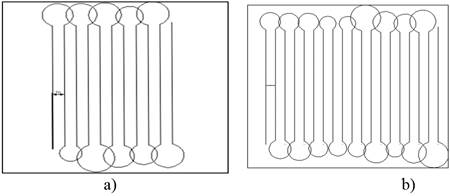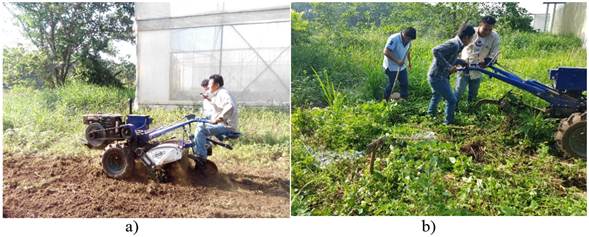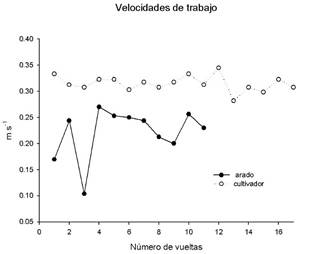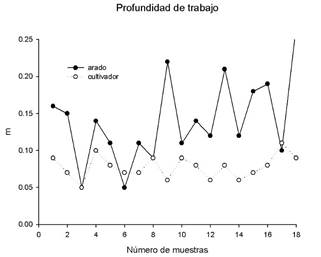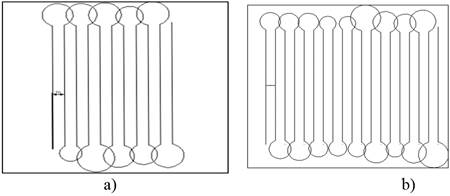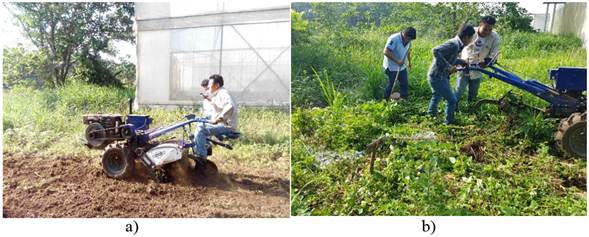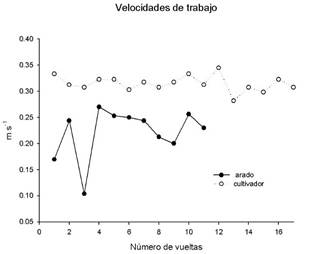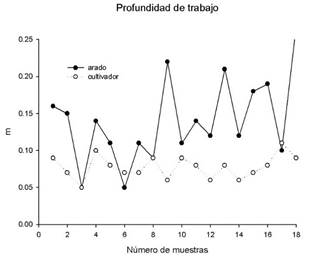Translate PaperTechnical Note http://opn.to/a/o0iT7
http://opn.to/a/o0iT7Testing of Technical and Operational Factors of a Walking Tractor with Plow and Cultivator
Dr. J. Antonio Yam-Tzec [I] [*]
Mauricio Alfonso-García [I]
[*] Author for correspondence: J. Antonio Yam-Tzec, e-mail: correoyam@hotmail.com
ABSTRACTNowadays in Mexico, there is an increasing in the acquisition of small tractors and walking tractors under 18 hp of power, however, there are no data on their operation. A walking tractor was evaluated with two implements plow and cultivator. The methodology used for the evaluation was the NMX-O-182-SCFI-2003 adapted. The test was fact on an area of 200 m2, in Papaloapan University, beginning with the operation of tillage with the plow and ending with the cultivator. The conditions in the soil were the slope of less than 5% and 10.9-14.2% humidity. The work quality indexes evaluated were the angle of rotation obtaining averages of 0.79 m in the plow and 0.69 m for the cultivator, the average fuel consumption were16 L/ha for the plow and of 12 L/ha for the cultivator. Work depths obtained were 0.14 m for the plow and 0.07 m for the cultivator.
INTRODUCTIONThe farm tractor is an important tool for agricultural activities because it reduces time, physical labor, increases the amount of surface worked, allows a wide range of implements for different activities to increment agricultural production
Similarly, reducing production costs allows overcoming the seasonal shortage of labor and releasing work in critical periods for other productive activities (Palacios y Ocampo, 2012).
The Valencia Institute of Exportation (2006) cited by Negrete et al. (2012) and Negrete et al. (2013), indicates that in Mexico 34% of the population is engaged in agricultural tasks with very small land areas, 85% of farmers have no more than 5 ha of arable land, including 90% does not reach 3 ha. That indicates the need to use light machinery, one option is the purchase of motor cultivator by its low cost of acquisition
Traditionally in the preparation of soils disc plows, disc harrows, subsoilers, scarifiers and others are used, which are extremely large equipment to be used within greenhouses (Olaguibel y Rubet, 2010). These implements usually have working widths above 1.5 m that characterize the distance between plants in the greenhouses of the region.
The motor cultivator is a source of power for agricultural work for small producers, since it allows performing activities similar to a tractor without the need of experience in the operation, besides optimizing the available spaces in protected agriculture, or in small areas in open field. The length of the area is one of the most important aspects. Due to that it is necessary to minimize the turning areas in the headboards to take advantage of the available space, since it cannot be turned outside the field because its sides are covered with the fabrics that protect cultures from contamination with pests and diseases (Ríos y Villarino, 2014).
In Mexico, even though there are support programs for the acquisition of machinery sponsored by the Federal Government SAGARPA (2017), information on the operation aspects of motor cultivators is not available.
Ayala et al. (2013) mentions that the user of agricultural machinery seeks safety in the operation and quality of tractors. For this reason, there is a need to carry out the relevant tests to evaluate the quality of work of an agricultural machinery.
Having the information obtained from the tests, would allow small producers in the region to make decisions in the acquisition of this equipment that has gained momentum in recent years.
The objective of the present work is to evaluate the operation characteristics of a motor cultivator with two implements (double furrow plow and cultivator). To carry out the evaluation, the Mexican norm NMX-O-182-SCFI (2003) was taken as a guide.
METHODSThe study was carried out in the municipality of Loma Bonita, Oaxaca at coordinates 18º 05 '52,8' 'LN and 95º 53' 46,8 '' LO, at 25 meters above sea level and an average annual temperature of 25ºC. The climate corresponds to a warm humid (Am), according to García (2004). An open field of 200 m2 (10 x 20 m) of surface area was used, located in the facilities of Universidad del Papaloapan campus Loma Bonita with less than 5% slope, 14.2% of maximum humidity. A motor cultivator of the brand KOREI was used. It had a diesel engine of 18 HP 4-stroke with water cooling and electric start, a gearbox of 6 speeds back and forth to work with or without implement and 2 reverse speeds (Table 1) (World Korei Corporation, 2017).
A double-furrow plow was used whose technical characteristics are shown in Table 2. It had a blade cultivator, a wooden box of 1 x 1 m was used for the sampling of weeds, digital scale, plastic bag, stopwatch, 10 m flexometer, 250 ml graduated cylinder, lime, convention industrial oven Binder® brand to obtain soil moisture percentage and a stroboscope brand TENMA® model 72-7601 to measure the angular speed of the engine flywheel.
The tests were carried out with the agricultural set using the "round-trip" movement method and the "open-loop" turnaround method, proposed by the Mexican Standard (Figure 1).
a) Behavior of the double furrow- plow turning radius b) Behavior of the cultivator turning radius
The methodology used as a guide for the evaluation of the agricultural set was the Mexican standard NMX-O-182-SCFI (2003). The motor cultivator was placed in the working position and the fuel tank was filled to its maximum capacity. The tests were carried out at an angular speed of the engine of 2 382 rpm in first gear on the plow and on the cultivator. The time, as well as the radius of each round were measured and five soil samples and five weed samples were taken, based on the standard (Figure 2).
Implement-tools in the test, a) cultivator and b) plow.
RESULTS AND DISCUSSIONThe turning radii were measured, obtaining an average of 0.79 m in the double plow and 0.69 m in the cultivator, averages below the 0.90 m mentioned in the technical data sheet of the motor cultivator.
These values are adequate, especially when working in small areas, it is lower than that obtained by Ríos & Villarino (2014), for a multi- plow Carraro tractor, whose turning radius was 2.04 m.
In relation to the incorporation of weeds, incorporations of 60.9% in the double furrow plow and 78.3% in the cultivator were obtained, values higher than 50% the Mexican norm accepts.
In relation to the soil moisture percentage, results of 10.9% were obtained for the double furrow plow and 14.2% for the cultivator. The measurements can be observed in Table 3. The norm establishes a percentage between 5 and 17% to perform the test.
The average speed calculated with the plow was 0.22 m/s. The fuel consumption was 0.385 liters, in a time of 0.35 hours. In the case of the cultivator, the average speed was 0.31 m/s, with a fuel consumption of 0.220 liters, in 0.29 hours (Figure 3). Both consumptions are within the range of specific consumptions established by Ayala et al. (2013), for agricultural machinery of power less than 20 hp (Ayala et al., 2014).
Registered velocity of the motor cultivator with plow and harrow.
The cost of fuel for the motor cultivator with the double furrow plow was 19.25 L / ha, in the cultivator the fuel consumption was 11 L / ha. Ranjbarian et al. (2017) reported the consumption of a tractor MF 285, average fuel consumption at different forward speeds of 25.05 L / ha for the disc plow, 25.4 L / ha for the mouldboard plow and 11.4 L / ha for the chisel plow on a tractor. Karparvarfard & Rahmanian (2015) reported 28.6 L / ha on a MF-399 tractor at speeds of 3 km / h for a cultivator at 5 cm deep on a clay soil. Although the comparison is of medium power tractors against the motor cultivator, the data reported by the authors serve as a reference to recommend the use of the motor cultivator as a power source, particularly, in small areas or protected crops.
The average depth measured in the double furrow plow was 0.147 m, which is between the values of 0.12-0.18 m established in the technical specifications and below the requirement mentioned by Villarino et al. (2011) of 0.16 m in a reversible plow using a Corsaro model motor cultivator.
In the cultivator, an average depth of 0.07 m was calculated, below the 0.11 m range established by the technical data sheet of the motor cultivator. Figure 4 shows the different depths obtained in both implements
Depths of work measured with the double furrow plow and cultivator.
CONCLUSIONSA motor cultivator of Korei ® brand was evaluated, with two implements, a double furrow plow and a cultivator. Turning radii were calculated obtaining averages of 0.79 m in the double furrow plow and 0.69 m for the cultivator; these values are acceptable if work is done inside a greenhouse. The average fuel consumption is 19.25 L/ha for the double furrow plow and 11 L/ha for the motor cultivator, which when compared to medium power tractors are below those reported by the authors. Working depths of 0.14 m for the double furrow plow and 0.07 m for the cultivator were obtained.
It is recommended to use the motor cultivator on small surfaces or in areas where a conventional tractor cannot have access to perform work, as well as in greenhouses, shade houses and in work of minimum traction requirements.
INTRODUCCIÓNEl tractor es una herramienta importante para las labores agrícolas porque reduce tiempos, el trabajo físico, incrementa la cantidad de superficie trabajada y permite una amplia gama de implementos para diferentes actividades buscando mejorar la producción agrícola.
De igual forma, al disminuir costos de producción, posibilita vencer la escasez estacional de mano de obra y liberar trabajo en periodos críticos para otras tareas productivas (Palacios y Ocampo, 2012).
El Instituto Valenciano de la Exportación (2006) citado por Negrete et al. (2012); Negrete et al. (2013), indica que en México el 34 % de la población se dedica a tareas agrícolas con superficies de tierra muy pequeñas, el 85 % de los campesinos no tienen más de 5 ha de terreno cultivable, entre ellos el 90 % no llega a las 3 ha lo cual indica la necesidad de usar maquinaria ligera, una opción es la compra de motocultores por su bajo costo de adquisición.
Tradicionalmente en la preparación de suelos se emplean arados de discos, gradas de discos, subsoladores, escarificadores y otros, los cuales son equipos extremadamente grandes para ser utilizados dentro de las casas de cultivo (Olaguibel y Rubet, 2010). Estos implementos normalmente tienen anchos de trabajo por arriba de 1,5 m que caracteriza la distancia entre plantas en los invernaderos de la región.
El motocultor es una fuente de potencia para las labores agrícolas para pequeños productores, ya que permite realizar las actividades similares a un tractor sin necesidad de experiencia en la operación, además de optimizar los espacios disponibles en la agricultura protegida, o en pequeñas áreas en campo abierto. La longitud del área es uno de los aspectos de mayor importancia, por lo cual es necesario minimizar las zonas de viraje en las cabeceras para aprovechar el espacio disponible, dado que no se puede girar fuera del campo por encontrarse cubiertos los laterales con las telas que protegen la casa y que no se deben alzar para evitar la contaminación con plagas y enfermedades (Ríos y Villarino, 2014).
En México, aun cuando existen programas de apoyo para la adquisición de maquinaria auspiciados por el Gobierno Federal SAGARPA (2017), no se encuentra disponible información sobre aspectos de operación de motocultores.
Ayala et al. (2013), menciona que el usuario de maquinaria agrícola, busca seguridad en el funcionamiento y calidad de los tractores. Por tal motivo se da la necesidad de realizar las pruebas pertinentes de evaluación de la calidad de trabajo de un conjunto agrícola.
Contar con la información obtenida a partir de las pruebas, permitiría a los pequeños productores de la región, tomar decisiones en la adquisición de estos equipos que ha cobrado auge en los últimos años.
El objetivo del presente es evaluar las características de operación de un motocultor con dos implementos (arado de doble surco y cultivador); para realizar la evaluación, se tomó como guía la norma mexicana NMX-O-182-SCFI (2003).
MÉTODOSEl estudio se realizó en el municipio de Loma Bonita, Oaxaca en las coordenadas 18º 05’ 52,8’’ LN y 95º 53’ 46,8’’ LO, a 25 msnm y una temperatura media anual de 25 ºC. El clima corresponde a un (Am), cálido húmedo de acuerdo con García (2004). Se utilizó un terreno en campo abierto de 200 m2 (10 x 20 m) de superficie, localizada en las instalaciones de la Universidad del Papaloapan campus Loma Bonita con pendiente menor a 5 % , 14,2 % de humedad máxima y un motocultor de la marca KOREI con un motor Diésel de 18 HP de 4 tiempos con enfriamiento por agua y arranque eléctrico, cuenta con una caja de velocidades que posee 6 marchas hacia atrás y hacia adelante para el trabajo con o sin implemento, posee 2 velocidades de reversa (Tabla 1) (World Korei Corporation, 2017).
Se utilizó un arado de doble surco cuyas características técnicas se muestran en la Tabla 2, cultivador de cuchillas; se empleó un cuadro de madera de 1 x 1 m para la toma de muestra de maleza; báscula digital, bolsa de plástico, cronómetro, flexómetro de 10 m, probeta graduada a 250 ml, cal, horno industrial de convención marca Binder® para obtención de porcentaje de humedad del suelo y estroboscopio marca TENMA® modelo 72-7601 para medir la velocidad angular del volante del motor.
Las pruebas se realizaron con el conjunto agrícola utilizando el método de movimiento de “ida y vuelta” y el método de viraje denominado de “lazo abierto”, propuesto por la Norma Mexicana (Figura 1).
Comportamiento de radios de giro del arado de doble surco a) y cultivador b).
La metodología utilizada como guía para la evaluación del conjunto agrícola fue la norma mexicana NMX-O-182-SCFI (2003). El motocultor se colocó en posición de trabajo y se llenó el tanque de combustible a su máxima capacidad, las pruebas se realizaron a una velocidad angular del volante del motor de 2 382 rpm en primera marcha en el arado y en el cultivador, se midió el tiempo, así como el radio de cada vuelta, se tomaron cinco muestras de suelo y cinco muestras de maleza, con base en la norma (Figura 2).
Implementos utilizados en la prueba a) cultivador y b) arado.
RESULTADOS Y DISCUSIÓNSe midieron los radios de giro, obteniendo un promedio de 0,79 m en el arado de doble surco y de 0,69 m en el cultivador, medias por debajo de los 0,90 m que menciona la ficha técnica del motocultor.
Estos valores son adecuados, en especial, cuando se trabaja en áreas pequeñas, es menor a lo obtenido por Ríos y Villarino (2014), para un tractor Carraro con multiarado, cuyo radio de giro fue de 2,04 m.
Con relación a la incorporación de maleza se obtuvo incorporaciones de 60,9% en el arado de doble surco y 78,3% en el cultivador, valores mayores al 50 % que acepta la norma mexicana.
Con relación al porcentaje de humedad del suelo, se obtuvieron resultados de 10,9% para el arado de doble surco y 14,2% para el cultivador. Se puede observar las mediciones en la Tabla 3, la norma establece un porcentaje entre 5 y 17% para realizar la prueba.
La velocidad promedio calculada con el arado fue de 0,22 m/s. El consumo de combustible fue de 0,385 litros, en un tiempo de 0,35 horas. Para el caso del cultivador, la velocidad promedio fue de 0,31 m/s, con un consumo de combustible de 0,220 litros, en 0,29 horas (Figura 3). Ambos consumos están dentro del rango de consumos específicos establecido por Ayala et al. (2013), para maquinaria agrícola de potencia menor a 20 hp (Ayala et al., 2014).
Velocidades registradas del motocultor con arado y cultivador.
El gasto de combustible del motocultor con el arado de doble surco es de 19,25 L/ha, en el cultivador el consumo de combustible fue de 11 L/ha, que comparado con el consumo de un tractor MF 285, Ranjbarian et al. (2017), reporta consumo medio de combustible a diferentes velocidades de avance de 25,05 L/ha para el arado de disco, 25,4 L/ha para el arado de vertedera y 11,4 L/ha para el arado de cincel en un tractor, y contra los 28,6 L/ha en un tractor MF-399 a velocidades de 3 km/h para un cultivador a 5 cm de profundidad hecha por Karparvarfard y Rahmanian (2015), en un suelo arcilloso. Aun cuando el comparativo es de tractores de potencia media contra el motocultor, los datos que se reportan por los autores sirven de referencia para poder recomendar el uso del motocultor como fuente de potencia, de manera particular en áreas pequeñas o en cultivos protegidos.
La profundidad promedio medida en el arado de doble surco fue de 0,147 m, que se encuentra entre los valores de 0,12-0,18 m que establece la ficha técnica y por debajo de la exigencia mencionada por Villarino et al. (2011) de 0,16 m en un arado reversible utilizando un motocultor modelo Corsaro.
En el cultivador, se calculó una profundidad promedio de 0,07 m, rango por debajo a los 0,11 m que establece la ficha técnica del motocultor, la Figura 4 muestra las diferentes profundidades obtenidas en ambos implementos.
Profundidades de trabajo medido con el arado de doble surco y cultivador.
CONCLUSIONESSe evaluó un motocultor de la marca Korei ®, con dos implementos, un arado de doble surco y un cultivador, se calcularon los radios de giro obteniendo promedios de 0,79 m en el arado de doble surco y 0,69 m para el cultivador, estos valores son aceptables si se realizan labores dentro de un invernadero. El consumo promedio de combustible es de 19,25 L/ha para el arado de doble surco y de 11 L/ha para el cultivador, que al compararse con tractores de potencia media se encuentran por debajo de lo reportado por los autores. Se obtuvieron profundidades de trabajo 0,14 m para el arado de doble surco y 0,07 m en el cultivador.
Se recomienda utilizar el motocultor en superficies pequeñas o en áreas donde un tractor convencional no pueda tener acceso a realizar labores, así como en invernaderos, casa sombra y en labores de requerimientos mínimos de tracción.

